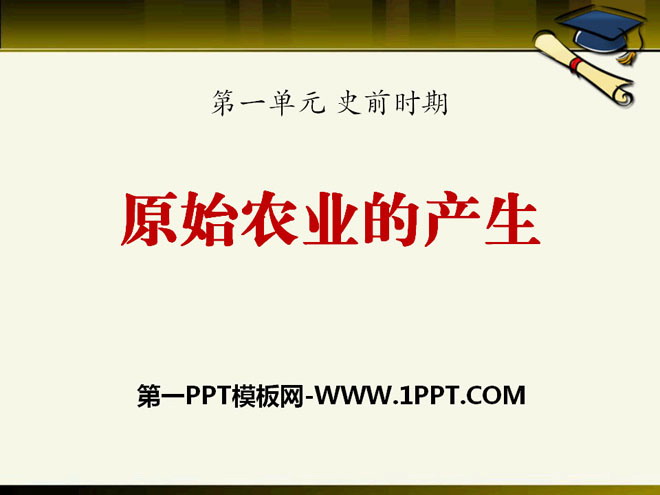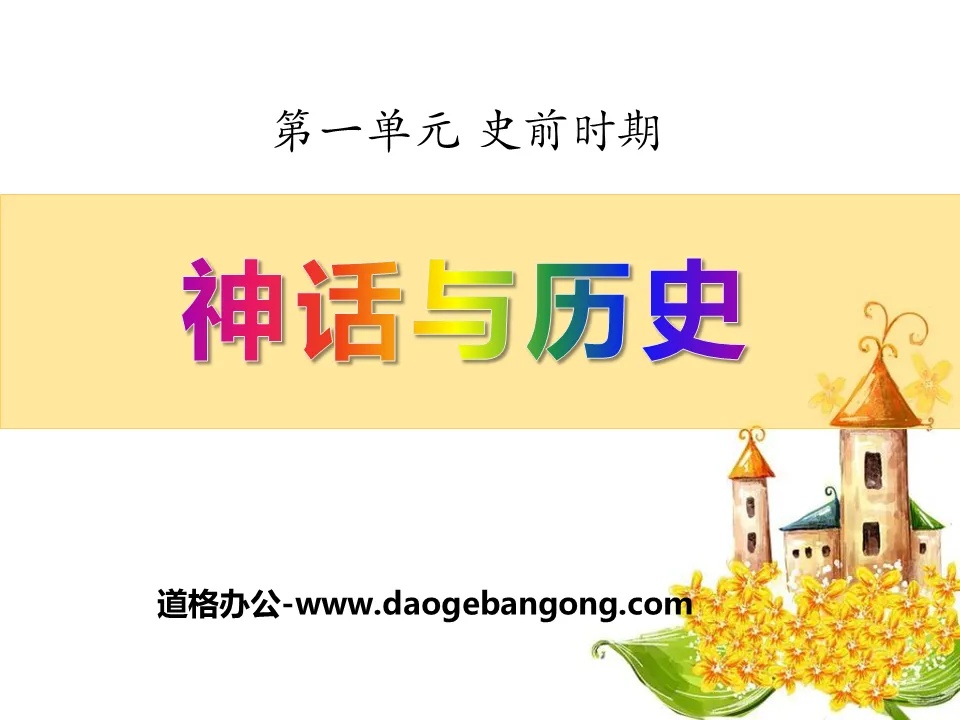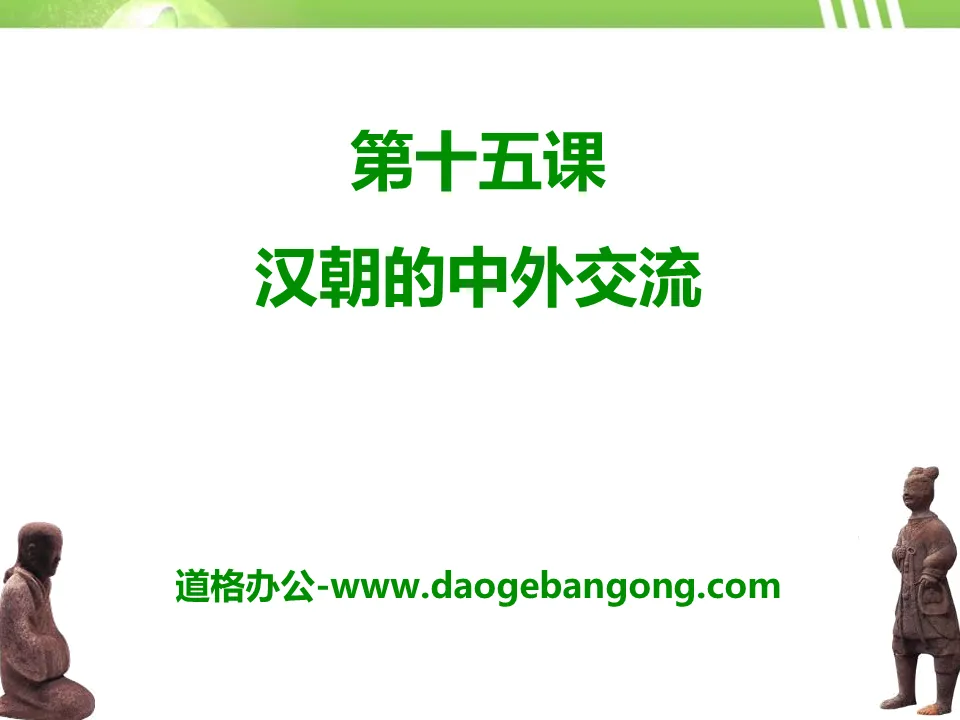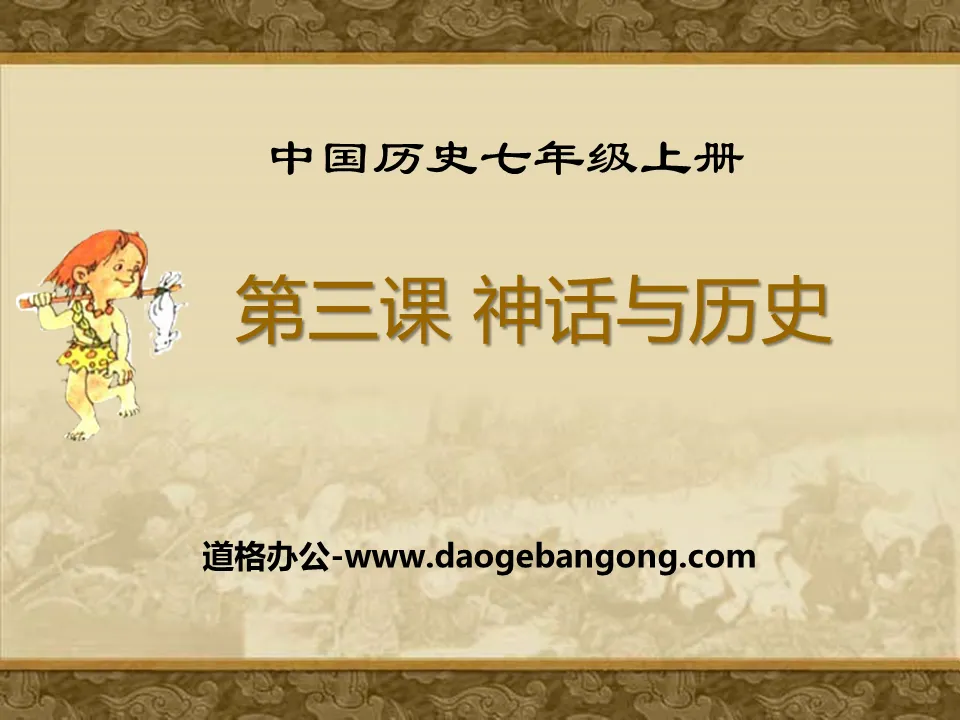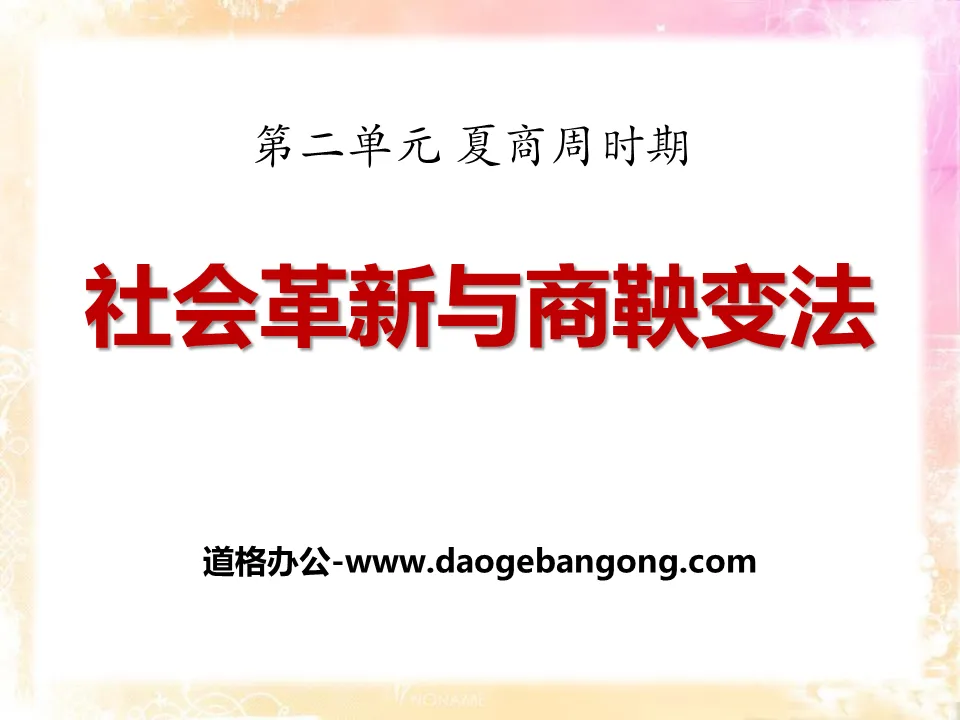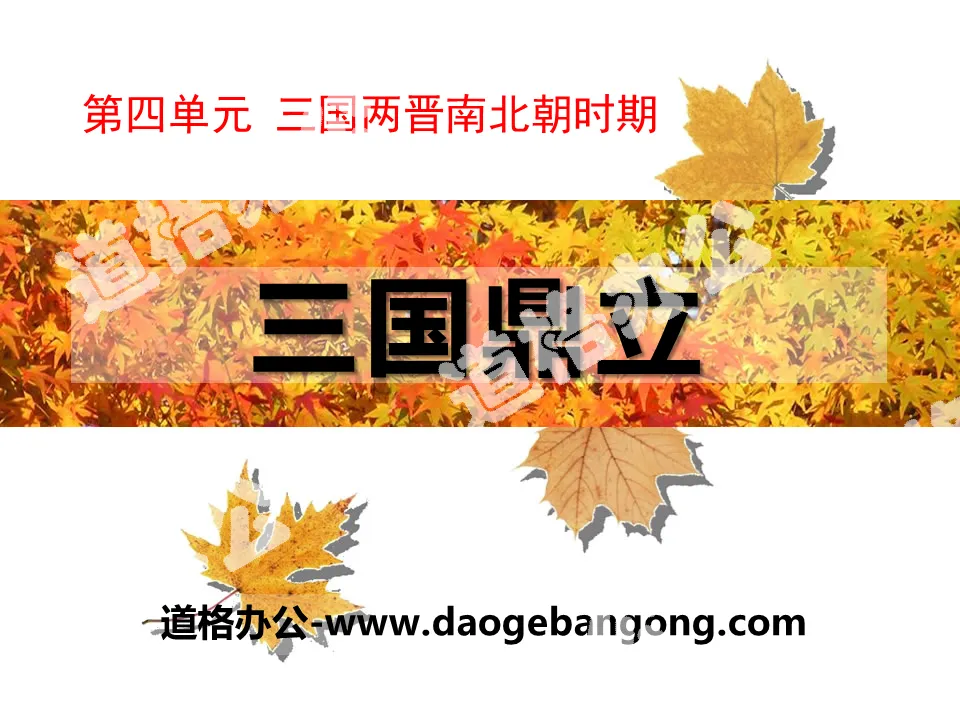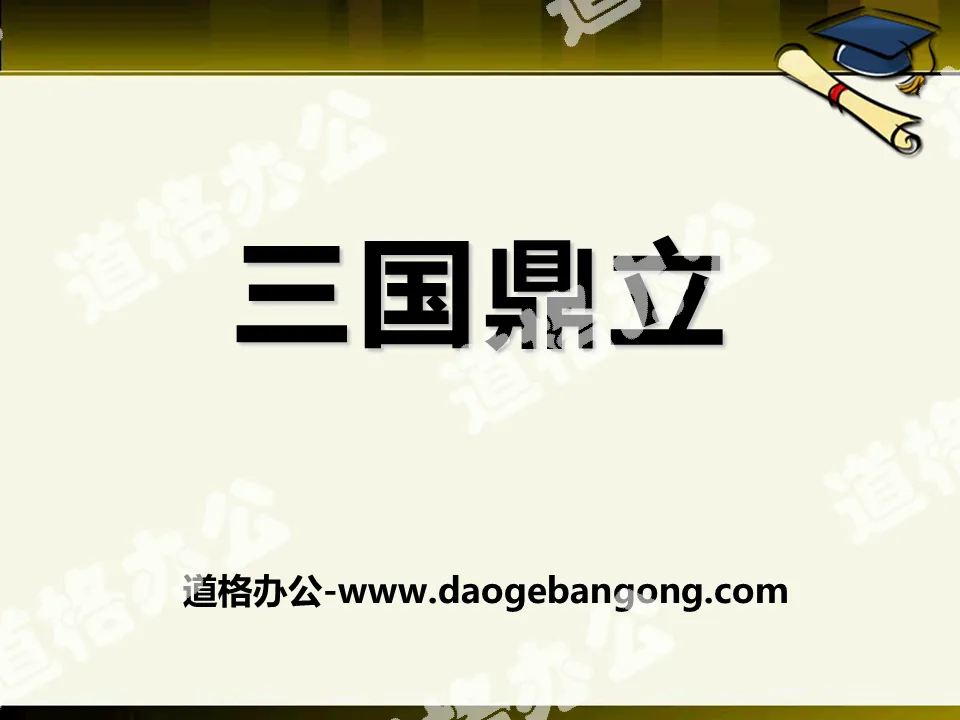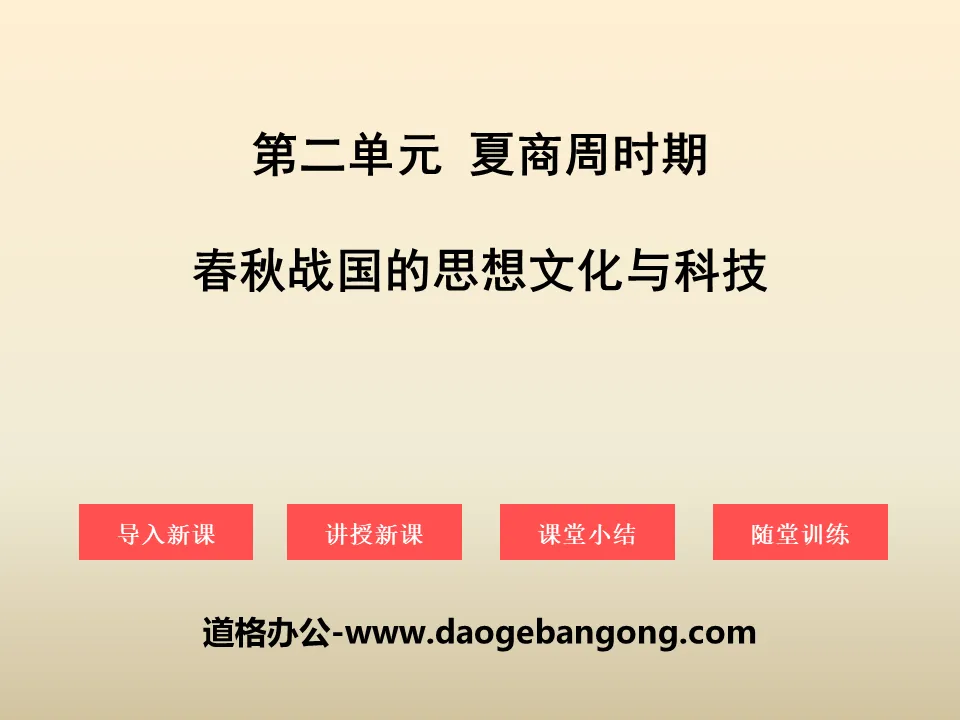
| Category | Format | Size |
|---|---|---|
| East China Normal University Edition Seventh Grade History Volume 1 | pptx | 6 MB |
Description
"Ideology, Culture and Technology in the Spring and Autumn and Warring States Period" PPT Courseware 3 during the Xia, Shang and Zhou Dynasties
learning target
1. Knowledge goals:
Understand the Confucian school founded by Confucius and Confucius' educational thoughts; understand the basic historical facts of Laozi, Mozi, Han Fei, Zhuangzi, Mencius and other scholars and the "Hundred Schools of Thought"; understand the relevant historical facts of Dujiangyan.
2. Capability goals:
Analyze the historical background of "A Hundred Schools of Thought" and "A Hundred Schools of Thought Contend", compare Confucianism, Taoism and Legalism, and cultivate students' analytical and comparative abilities.
3. Emotional goals:
Understand that Confucius is a great thinker and educator in ancient my country. His Confucianism, after being transformed and applied by successive rulers, occupies a dominant position in traditional Chinese culture and has a great influence on later generations.
1. "Hundred schools of thought"
The formation of the situation of "a hundred schools of thought contending"
What is "a hundred schools of thought contending"? How did the situation of "a hundred schools of thought contend" come about?
1. Confucianism
(1) Confucius
What kind of person do you know Confucius is?
Confucius, named Qiu and courtesy name Zhongni, was a native of Qufu, State of Lu during the Spring and Autumn Period. Confucius is the founder of Confucianism. He is a great thinker and educator who has great influence in China and the world.
Discuss
Can you tell us the story of "tyranny is stronger than tigers"?
What thoughts of Confucius does this story reflect?
Ideology: Promote "benevolence" and "propriety"
The core of Confucianism is "benevolence". What is the main meaning of "benevolence"? do you know?
"Benevolence" is the principle of life, requiring love and compassion, but love and compassion must abide by the norms of "propriety". "Etiquette" is a code of conduct that embodies the hierarchical order.
Confucius called the highest state of life "the golden mean", that is, being impartial and keeping everyone in their proper place. What he yearns for is the ancient world of great harmony.
"Benevolence" includes various connotations such as respect, tolerance, trust, sensitivity, benefit, righteousness, wisdom, courage, studiousness, love for others, self-restraint and etiquette, and a heart that respects oneself and others.
Reading and Thinking
What do you think after learning the relevant knowledge about "Confucius' lifelong efforts"? Today, more than two thousand years later, how do you understand the need for lifelong learning?
Thoughts: Confucius became a great thinker and educator, which was the result of his unremitting efforts throughout his life. If a person wants to achieve a certain career, he must study hard, keep learning, and learn for life.
Understanding: Today's society is changing and advancing by leaps and bounds. Only lifelong learning can keep up with the pace of the times and never fall behind.
(2) Mencius
Era: Warring States Period.
Main ideas: "Benevolent government", advocating "the people are more important than the king"; attaching importance to the role of people, believing that "the weather is not as good as the right place, and the right place is not as good as the people", "wealth cannot be licentious, poverty cannot be moved, and power cannot bend".
Thoughts and Discussions
How should we promote the awe-inspiring righteousness in today's society that "wealth and honor cannot be promiscuous, poverty and lowliness cannot be moved, and power cannot be subjugated"?
No matter what the circumstances, no matter what changes occur, the basic principles of life cannot be changed.
2. Taoism
(1) Lao Tzu
Introduction: The founder of Taoism is Laozi (also known as Li Er), who wrote the book "Laozi" (also known as "The Tao Te Ching").
Thoughts: simple dialectics; advocating conforming to nature and "governing by doing nothing"; yearning for a social life of "a small country with few people".
(2) Zhuangzi
The era: the middle period of the Warring States Period.
Main idea: further develop Laozi's "inaction" thought into equalizing all things and myself, equalizing right and wrong, equalizing life and death, equalizing big and small, and equaling noble and inferior, in order to achieve a state where "heaven and earth coexist with me, and all things are one with me".
3. Legalism——Han Fei
(1) The master of Legalist theory was ______ at the end of ______, and his work was ______.
(2) His propositions include:
History is ____________;
emphasize____________;
Advocate ____________.
4. Mohism—Mozi
(1) The founder of Mohism, a native of the Song Dynasty during the Spring and Autumn Period and the Warring States Period. Mohism and Confucianism are both known as the "explicit schools" among the schools of thought.
(2) Main ideas: advocates "non-offensive" and "universal love" and opposes unjust wars; advocates "promoting talents" and opposes nepotism; advocates "thrift" and opposes luxury and waste.
2. Dujiangyan
Reason for construction: Chengdu Plain is often hit by floods and droughts
Host: Li Bing, Governor of Shu County, Qin State
Location: Dujiangyan City, north of Chengdu, Sichuan
Function: flood control, water storage, irrigation
Meaning: Turn the Chengdu Plain into fertile fields
Classroom drill
1. The founder of Confucianism is ( )
A.Lao Tzu
B. Mencius
C.Confucius
D.Xunzi
2. The thinker who put forward the view that "the people are more important than the monarch" is ( )
A.Lao Tzu
B. Mencius
C.Confucius
D.Xunzi
3. Which of the following opinions does not belong to Han Fei ( )
A. Oppose unjust wars
B. Reforms should be carried out according to actual needs
C. Power should be concentrated in the hands of the monarch
D. Rule the country by law
Keywords: teaching courseware on the ideology, culture and science and technology of the Spring and Autumn Period and the Warring States Period, teaching courseware on the Xia, Shang and Zhou dynasties, download the history PPT courseware for the first volume of the seventh grade version of East China Normal University, download the history slide courseware for the seventh grade, download PPT courseware on the ideology, culture and science and technology of the Spring and Autumn Period and the Warring States Period. , PPT courseware download for the Xia, Shang and Zhou dynasties, in .PPT format;
For more information about the PPT courseware "Ideology, Culture and Science and Technology in the Spring, Autumn and Warring States Periods during the Xia, Shang and Zhou Periods", please click on the Ideology, Culture and Science and Technology during the Spring, Autumn and Warring States Periods during the Xia, Shang and Zhou Periods ppt tag.
"Ideology, Culture and Technology in the Spring and Autumn and Warring States Period" PPT Courseware 2 of Xia, Shang and Zhou Dynasties:
"Ideology, Culture and Technology in the Spring and Autumn and Warring States Period" PPT Courseware 2 of the Xia, Shang and Zhou Periods Read the first paragraph of P44 and answer: 1. In which period did the various schools of thought appear? 2. What do the various schools of thought refer to? 3. What kind of situation does the heated debate among various schools of thought create? Taoist Laozi...
"Ideology, Culture and Technology in the Spring and Autumn and Warring States Period" PPT courseware during the Xia, Shang and Zhou Dynasties:
"Ideology, Culture and Technology in the Spring and Autumn and Warring States Period" PPT courseware for the Xia, Shang and Zhou dynasties. Read the book with questions: 1. What are the Hundred Schools of Thought? 2. How did the situation of contention among a hundred schools of thought come about? 3. What is the background of this situation? Read and answer quickly: 1. The founding of Taoism..
File Info
Update Time: 2024-07-06
This template belongs to History courseware East China Normal University Edition Seventh Grade History Volume 1 industry PPT template
"Ideology, Culture and Technology in the Spring and Autumn and Warring States Period" PPT Courseware 3 during the Xia, Shang and Zhou Dynasties Simple campus recruitment activity planning plan summary enterprise and institution recruitment publicity lecture PPT template is a general PPT template for business post competition provided by the manuscript PPT, simple campus recruitment activity planning plan summary enterprise and institution recruitment promotion Lecture PPT template, you can edit and modify the text and pictures in the source file by downloading the source file. If you want more exquisite business PPT templates, you can come to grid resource. Doug resource PPT, massive PPT template slide material download, we only make high-quality PPT templates!
Tips: If you open the template and feel that it is not suitable for all your needs, you can search for related content "Ideology, Culture and Technology in the Spring and Autumn and Warring States Period" PPT Courseware 3 during the Xia, Shang and Zhou Dynasties is enough.
How to use the Windows system template
Directly decompress the file and use it with office or wps
How to use the Mac system template
Directly decompress the file and use it Office or wps can be used
Related reading
For more detailed PPT-related tutorials and font tutorials, you can view: Click to see
How to create a high-quality technological sense PPT? 4 ways to share the bottom of the box
Notice
Do not download in WeChat, Zhihu, QQ, built-in browsers, please use mobile browsers to download! If you are a mobile phone user, please download it on your computer!
1. The manuscript PPT is only for study and reference, please delete it 24 hours after downloading.
2. If the resource involves your legitimate rights and interests, delete it immediately.
3. Contact information: service@daogebangong.com
"Ideology, Culture and Technology in the Spring and Autumn and Warring States Period" PPT Courseware 3 during the Xia, Shang and Zhou Dynasties, due to usage restrictions, it is only for personal study and reference use. For commercial use, please go to the relevant official website for authorization.
(Personal non-commercial use refers to the use of this font to complete the display of personal works, including but not limited to the design of personal papers, resumes, etc.)
Preview



